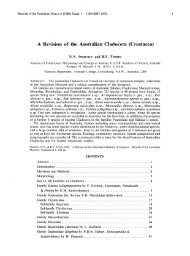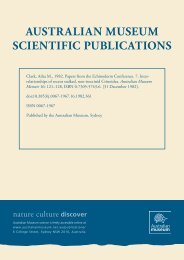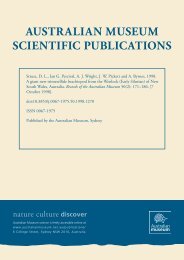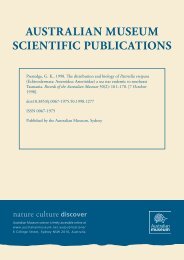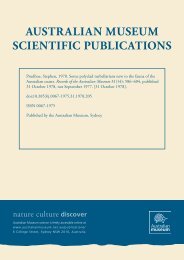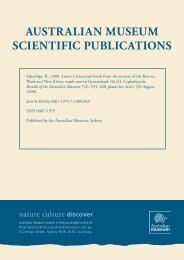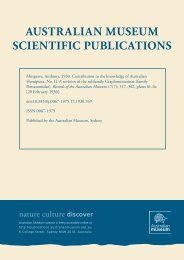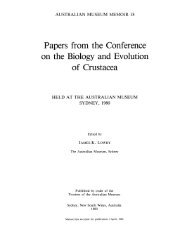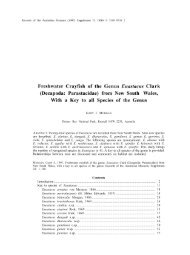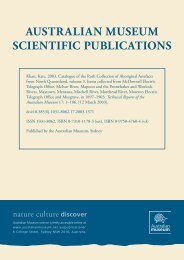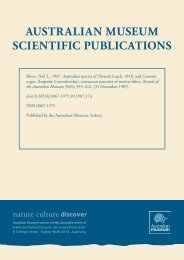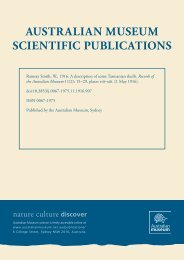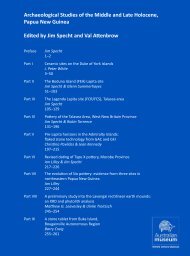Biogeographic and biostratigraphic implications of the - Australian ...
Biogeographic and biostratigraphic implications of the - Australian ...
Biogeographic and biostratigraphic implications of the - Australian ...
You also want an ePaper? Increase the reach of your titles
YUMPU automatically turns print PDFs into web optimized ePapers that Google loves.
22 Records <strong>of</strong> <strong>the</strong> <strong>Australian</strong> Museum (2009) Vol. 61<br />
resembles <strong>the</strong> Sa, but is asymmetrical with a more convex<br />
outer lateral face (Fig. 10E–G). The Sc element is identical<br />
with <strong>the</strong> asymmetrical element represented by <strong>the</strong> holotype <strong>of</strong><br />
<strong>the</strong> species from <strong>the</strong> Liangjiashan Formation <strong>of</strong> North China<br />
(An et al., 1983, pl. 12, fig. 26) with a convex outer lateral<br />
face <strong>and</strong> concave inner lateral face <strong>and</strong> with several costae<br />
(2 to 4) near <strong>the</strong> anterior margin (Fig. 10H–K). Zhen et al.<br />
(in press a, fig. 9G–L) reported <strong>the</strong> occurrence <strong>of</strong> this species<br />
in <strong>the</strong> Honghuayuan Formation in Guizhou. The Sc element<br />
recently illustrated from <strong>the</strong> Honghuayuan Formation in<br />
Guizhou (Zhen et al., in press a, fig. 9G–I) shows a more<br />
compressed base, <strong>and</strong> <strong>the</strong> Sa element (Zhen et al., in press a,<br />
fig. 9J–L) has <strong>the</strong> base less extended posteriorly, with costae<br />
on <strong>the</strong> lateral face more towards anterior.<br />
Semiacontiodus Miller, 1969<br />
Type species. Semiacontiodus nogamii Miller, 1969.<br />
Semiacontiodus sp. cf. Semiacontiodus<br />
cornuformis (Sergeeva, 1963)<br />
Fig. 15L–T<br />
Scolopodus cornuformis Sergeeva.—An, 1987: 183, pl. 7,<br />
figs 10–11, 13–16; Ding et al. in Wang, 1993: 202, pl. 5,<br />
fig. 33; Zhen et al., in press a: fig. 9D–F.<br />
Material. 26 specimens from three samples (Table1).<br />
Remarks. Three morphotypes <strong>of</strong> this species are recognized<br />
in <strong>the</strong> Emanuel samples representing a symmetry transition<br />
series including symmetrical Sa (Fig. 15L,M), asymmetrical<br />
Sb (Fig. 15N,O), <strong>and</strong> strongly asymmetrical <strong>and</strong> laterally<br />
more compressed Sc (Fig. 15P–T) elements. Although <strong>the</strong>se<br />
specimens have relatively shorter bases, <strong>the</strong>y o<strong>the</strong>rwise<br />
resemble those <strong>of</strong> S. cornuformis (Sergeeva, 1963), which<br />
was revised as consisting <strong>of</strong> a septimembrate apparatus<br />
(Löfgren, 1999).<br />
Serratognathus Lee, 1970<br />
Type species. Serratognathus bilobatus Lee, 1970.<br />
Serratognathus bilobatus Lee, 1970<br />
Fig. 11A–L<br />
Serratognathus bilobatus Lee, 1970: 336, pl. 8, figs 6, 7;<br />
Metcalfe, 1980: pl. 1, figs 16–19; An, 1981: pl. 2, fig. 26;<br />
An & Ding, 1982: pl. 5, fig. 25; An et al., 1983: 149, pl.<br />
16, figs 20–22, pl. 17, figs 1, 2; An, 1987: 189, 190, pl.<br />
18, fig. 11; Ding, 1987: pl. 6, fig. 16; An & Zheng, 1990:<br />
pl. 7, fig. 13; Ding et al. in Wang, 1993: 207, pl. 20, fig.<br />
5; Chen & Wang, 1993: fig. 2Q, 2U; Wang et al., 1996:<br />
pl. 2, figs 1–7, 9; Nicoll & Metcalfe, 2001: fig. 6.19–6.22;<br />
Metcalfe, 2004: pl. 2, figs 9–10.<br />
Material. Seven specimens from three samples (Table 1).<br />
Diagnosis. Species <strong>of</strong> Serratognathus with a trimembrate<br />
apparatus, including symmetrical Sa, asymmetrical Sb,<br />
<strong>and</strong> strongly asymmetrical Sc elements; all elements semiconical<br />
in outline with fan-shaped array <strong>of</strong> small, closely<br />
spaced denticles along anterior <strong>and</strong> lateral edges <strong>of</strong> overlapping<br />
laminar layers; cusp small, posteriorly positioned <strong>and</strong><br />
anterolaterally enclosed by up to 16 vertically overlapping<br />
laminar layers, which are anterobasally divided by a broad<br />
median groove into two lobe-like lateral processes; basal<br />
cavity absent.<br />
Description. Trimembrate apparatus, including symmetrical<br />
Sa, asymmetrical Sb, <strong>and</strong> strongly asymmetrical Sc elements<br />
which form a symmetry transition series; each element<br />
semi-conical in outline, formed by upwardly overlapping<br />
layers, resembling a half-cut onion; composed <strong>of</strong> <strong>the</strong> cusp<br />
<strong>and</strong> a gently posterolaterally extended lobe-like lateral<br />
process on each side. Cusp small or indistinctive, weakly<br />
compressed laterally with a broad posterior face, <strong>and</strong> <strong>the</strong><br />
anterior margin embedded in up to 16 surrounding overlapping<br />
layers, which are bordered by small, closely spaced<br />
denticles along <strong>the</strong> anterior <strong>and</strong> lateral margins. Discrete<br />
denticles surround <strong>the</strong> cusp in a semicircle, representing<br />
<strong>the</strong> anterolateral edge <strong>of</strong> each overlapping layer. Node-like<br />
denticles weakly developed on posterior face, may be absent<br />
towards <strong>the</strong> base (Fig. 11B, E, G, I); fine striae microstructure<br />
best developed on <strong>the</strong> posterior face in <strong>the</strong> area above<br />
<strong>the</strong> basal margin (Fig. 11 I, J). Denticulate anterior margin<br />
<strong>of</strong> each layer turned upwards. Basal face smooth, wide, <strong>and</strong><br />
distally arched; crescentic in outline in basal view; bisected<br />
by anteroposteriorly directed median groove extending<br />
anterobasally to separate into two lobes underneath each<br />
lateral process. Basal cavity absent; basal end <strong>of</strong> <strong>the</strong> cusp<br />
represented by a small ring-like node (Fig. 11K), but in one<br />
specimen basal cavity represented by a small, shallow pit<br />
underneath <strong>the</strong> cusp (Fig. 11B).<br />
Sa element symmetrical, outline crescentic in upper view<br />
with convex anterior face <strong>and</strong> concave posterior face, <strong>and</strong><br />
tower-like in anterior view (Fig. 11A). Cusp small, located<br />
posteromedially with a short lobe-like process on each<br />
side, which extends posterolaterally; in anterior view, two<br />
processes separated anterobasally by a prominent ra<strong>the</strong>r deep<br />
median groove (Fig. 11A). Basal face smooth, bisected by<br />
<strong>the</strong> median groove into two symmetrical lobes.<br />
Sb element (Fig. 11B–F) like Sa, but asymmetrical; inner<br />
lateral process shorter in posterior view (Fig. 11B), extending<br />
laterally with basal margin nearly horizontal; outer lateral<br />
process longer extending posterolaterally (Fig. 11C). Basal<br />
margin <strong>of</strong> <strong>the</strong> two processes forming an angle <strong>of</strong> 125° or<br />
more in <strong>the</strong> upper view (Fig. 11E). Basal face asymmetrical,<br />
with a longer lobe under outer lateral process <strong>and</strong> a shorter<br />
lobe under inner lateral process. One specimen (Fig. 11B)<br />
exhibits a small <strong>and</strong> shallow basal cavity.<br />
Sc element (Fig. 11G–L) similar to Sb, but strongly<br />
asymmetrical with longer <strong>and</strong> more strongly posteriorly<br />
extended lateral processes. In upper view, <strong>the</strong> basal margins<br />
<strong>of</strong> <strong>the</strong> two lateral processes form a ra<strong>the</strong>r narrower angle<br />
<strong>of</strong> about 70–80° (Fig. 11G, L); outer lateral process longer<br />
(Fig. 11G, L).<br />
Remarks. Lee (1970) illustrated two specimens <strong>of</strong><br />
Serratognathus bilobatus from <strong>the</strong> Dumugol Formation <strong>of</strong><br />
South Korea, with <strong>the</strong> figured holotype (Lee, 1970, pl. 8, fig.<br />
7a–d) assignable to <strong>the</strong> asymmetrical Sb element defined<br />
herein <strong>and</strong> <strong>the</strong> o<strong>the</strong>r figured paratype (Lee, 1970, pl. 8, fig.<br />
6) is a symmetrical Sa element. Both specimens are identical<br />
with those from <strong>the</strong> Emanuel Formation. Serratognathus<br />
bilobatus differs from S. diversus An, 1981 (Figs 12–14)<br />
from <strong>the</strong> Honghuayuan Formation <strong>of</strong> South China mainly in<br />
having a smaller, <strong>of</strong>ten indistinct, cusp (Fig. 11G, H).




